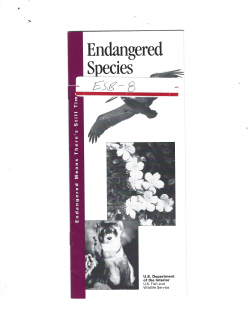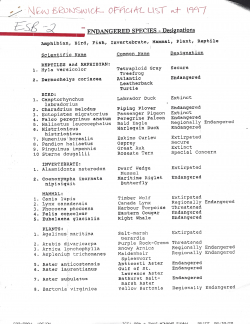Why Save Endangered Species - Endangered Means There's Still Time

Type
Publication
Authors
USDI ( US Department of The Interior )
USDI-USFSW ( US Department of the Interior - US Fish and Wildlife Service )
Category
SCIWC Library
[ Browse Items ]
Publication Year
1993
Pages
5
Subject
Endangered Species
Tags
Abstract
"Since life began on this planet, countless creatures have come and gone - rendered extinct by naturally changing physical and biological conditions.
If extinction is part of the natural order, and if many other species remain, some people ask: 'Why save endangered species? What makes these animals and plants so special that money and effort should be spent to conserve them?'
congress addressed these questions in the preamble to the Endangered Species Act of 1973, recognizing that endangered species of fish, wildlife, and plants 'are of esthetic, ecological, educational, historical, recreational, and scientific value to the Nation and its people.' In this statement, Congress was summarizing a number of convincing arguments advanced by scientists, conservationists, and others who are greatly concerned by the disappearance of unique creatures.
Unfortunately, the accelerating decline of our wild animals and plants is less and less natural. Biologists know that today's danger to wildlife most often results from habitat degradation, environmental pollution, the introduction of exotic (non-native) organisms, and exploitation - all generally as a direct result of human activities.
Although conservation efforts have begun in recent years, mankind is still exterminating entire species at an ever-increasing rate. Since the Pilgrims landed at Plymouth Rock in 1620, more than 500 species, subspecies, and varieties of our Nation's plants and animals have become extinct - lost forever. (By contrast, during the 3,000 years of the Pleistocene Ice Age, all of North America lost only about three species every 100 years.) The situation today is even worse in other parts of the world. "
If extinction is part of the natural order, and if many other species remain, some people ask: 'Why save endangered species? What makes these animals and plants so special that money and effort should be spent to conserve them?'
congress addressed these questions in the preamble to the Endangered Species Act of 1973, recognizing that endangered species of fish, wildlife, and plants 'are of esthetic, ecological, educational, historical, recreational, and scientific value to the Nation and its people.' In this statement, Congress was summarizing a number of convincing arguments advanced by scientists, conservationists, and others who are greatly concerned by the disappearance of unique creatures.
Unfortunately, the accelerating decline of our wild animals and plants is less and less natural. Biologists know that today's danger to wildlife most often results from habitat degradation, environmental pollution, the introduction of exotic (non-native) organisms, and exploitation - all generally as a direct result of human activities.
Although conservation efforts have begun in recent years, mankind is still exterminating entire species at an ever-increasing rate. Since the Pilgrims landed at Plymouth Rock in 1620, more than 500 species, subspecies, and varieties of our Nation's plants and animals have become extinct - lost forever. (By contrast, during the 3,000 years of the Pleistocene Ice Age, all of North America lost only about three species every 100 years.) The situation today is even worse in other parts of the world. "
Description
This document is an informational brochure on Endangered Species produced by the U.S Department of the Interior and the U.S Fish and Wildlife.
Topics covered include:
- The Benefits of Natural Diversity
- Medicine
- Agriculture
- Environmental Monitors
- Ecosystems Under Pressure
- How You Can Help
Topics covered include:
- The Benefits of Natural Diversity
- Medicine
- Agriculture
- Environmental Monitors
- Ecosystems Under Pressure
- How You Can Help
Number of Copies
1
| Library | Accession No | Call No | Copy No | Edition | Location | Availability |
|---|---|---|---|---|---|---|
| SCIWC Administration | 13178 | ESB-6 | 1 | Yes |




